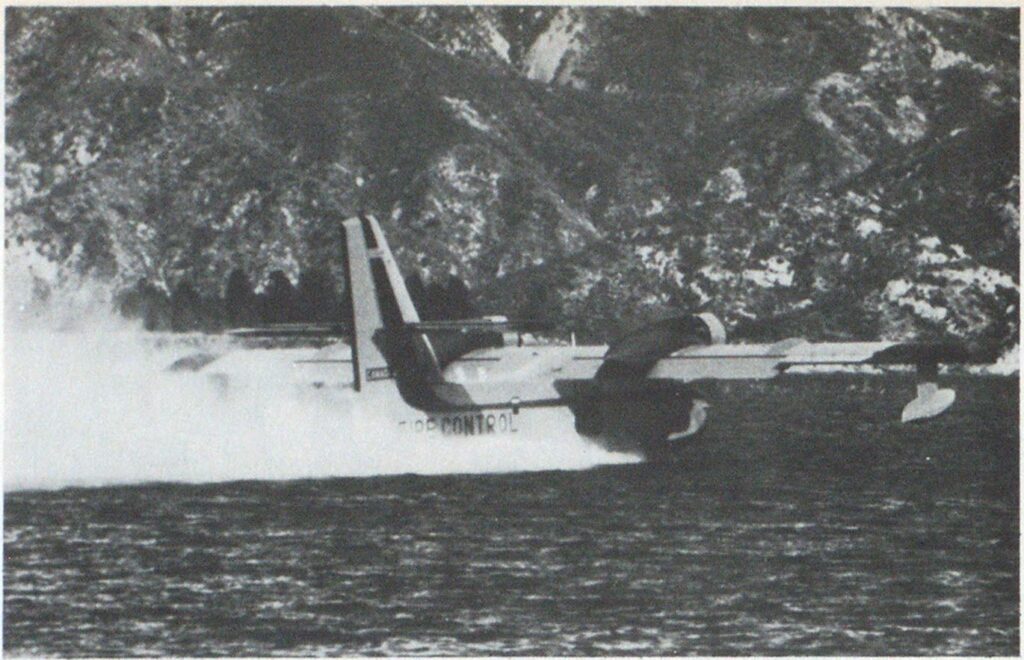
Planes Scoop To Reload for Water Drops

Two red and yellow twin-engine airplanes designed for fighting forest fires have been tested by the Los Angeles City and County Fire Departments.
Instead of returning to an airport to refill with water, the pilots simply flew their aircraft to the nearest body of water and refilled the tanks by skimming along the surface at 80 mph. Working together, the two planes could drop over 16,000 gallons of water on a fire every hour. Known officially as the Canadair CL-215s, the planes were quickly nicknamed “SuperScoopers.”
Most aerial fire fighting today is done with converted military aircraft and helicopters—mostly operated by large agencies such as the United States Forest Service and the California Department of Forestry. These planes include the B-17, a four-engine WWII bomber; the DC-6, a four-engine commercial airliner; the C-119, an Air Force cargo plane; and the S-2, a two-engine plane originally designed for naval anti-submarine warfare. Since none of these planes was designed for fire fighting, they have definite disadvantages in this use, such as poor performance and maneuverability when fully loaded, poor visibility from the cockpit, relatively difficult to fly, high fuel consumption and operating costs, and poor parts availability. Many agencies use helicopters, such as Bell-212s, for aerial fire fighting, but their effectiveness is limited by the small amount of water they can carry.
Designed to fight fires
The Canadair CL-215 is designed specifically for fire fighting. The plane is 65 feet long and 29 feet high, and it has a wingspan of 93 feet. The maximum takeoff weight of the plane is 43,500 pounds with a possible payload of 12,000 pounds. It is powered by two Pratt and Whitney R-2800 engines which can develop up to 4200 hp.

This high power-to-weight ratio allows the fully loaded aircraft to take off after a run of only 1900 feet and climb at over 1000 feet per minute. The large wingspan and high horizontal stabilizer allow the plane to fly at air speeds as low as 100 knots with excellent maneuverability. This combination of low speed, high maneuverability, and well designed cockpit visibility allows accurate water dropping. The plane can safely scoop and drop water in winds up to 40 mph.
The plane’s fuel consumption is a reasonable 116 gallons per hour. On patrol, the plane can fly up to 10 hours without refueling. On a water dropping mission, the number of drops between refuelings will vary from 15 to 25, depending mainly on the distance from the fire to a suitable body of water.
In a study done by test pilot James Morrison for the Los Angeles City Board of Fire Commissioners, the hourly operating costs of the CL-215 were calculated to be $507 per hour compared to $140 per hour for the Los Angeles City Bell 205A helicopters. When comparing the cost per gallon of water dropped, the CL-215 was 8.6 cents per gallon-hour and the helicopter 14.3 cents per gallon-hour. Since four helicopters would be needed to drop the same amount of water as one aircraft, the costs for helicopters would rise to 57.2 cents per gallon-hour.
Tanks filled in 10 seconds
The CL-215 can carry up to 1500 gallons of water in two fiberglass tanks in the center of the cabin. The tanks can be filled in less than two minutes through ground fittings on each side of the fuselage or in 10 seconds through retractable probes under the hull as the aircraft skims over the water.
An onboard system is available for mixing fire retardant and water during scooping. Any body of fresh or salt water at least 6 feet deep and ¾ of a mile long with reasonably clear access can be used for scooping water. Swells up to 10 feet high have presented no problems.
Patterns for water drops can either be by salvo (20 by 90 yards) or train (10 by 150 yards). In the first pattern, both tanks drop simultaneously while in the latter, they drop consecutively.
The SuperScoopers have been used successfully for a number of years in Canada, France, Spain, Greece, and recently Alaska.

